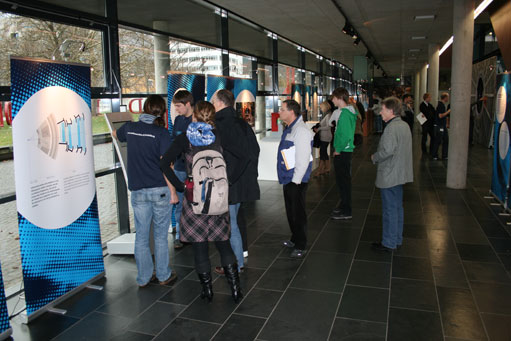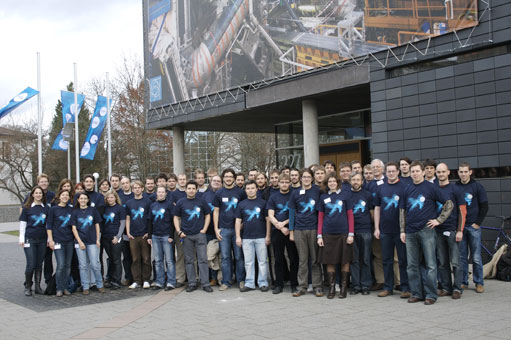
ATLAS e-News
23 February 2011
Weltmaschine in Heidelberg
13 January 2010

The ATLAS banner visits the Kirchhoff Institute for the "World machine" exhibition.
The Weltmaschine (World machine) exhibition on the LHC opened at Heidelberg University on November 26th, attended by a representative of the German ministry for education and research and Rüdiger Voss from CERN. It was originally developed for the U-Bahnhof of Berlin, bringing high-tech science to the people by setting up in a train station. This time, the exhibition was further from the city centre, at the Kirchhoff Institute for physics, but it still attracted 4,000 visitors by the time it closed December 20th.
The information portion of the exhibition comes in the form of signs that roll up for storage, about a metre wide by two metres tall when unfurled. Alongside the text and images, attendees of the exhibition saw parts of the detectors, such as an ATLAS MDT module or a model of the ALICE time projection chamber (TPC). One of the popular exhibits was a separated box of light and dark coloured sand, representing matter and antimatter for LHCb. As the University of Heidelberg is active in ALICE, ATLAS, and LHCb, the exhibition was focussed on these experiments.

Volunteers explain particle physics to exhibition visitors
Of course, the Weltmaschine itself had a strong presence, represented in the cross section of a blue dipole and a hands-on mechanical “particle accelerator” that allowed exhibition-goers to accelerate a ball along a rail. Tiny particles like those produced in the LHC showed up in cloud and spark chambers.
In early December, the LHC was running, and the exhibition took advantage of the excitement. “We had a terminal which basically had four screens in a square, and we just displayed live information from CERN,” says Rainer Stamen, one of the five organisers. These screens showed information about the beam, event displays from the experiments, and the webcams of the experimental control rooms.
Around 70 students and post-docs lent their time to setting up and running the exhibition. These volunteers guided about 70 tours of the exhibition hall on weekdays, answering questions and explaining the modules, and four guides were around during the weekends for additional tours. They also ran a cafeteria, offering a chance to take a break and get some brain food.
During the week, the exhibition hall was largely peopled by school groups. Fifty classes visited, totalling near 1,200 students. While talks by professors were saved for the weekends, one room played CERN outreach videos on repeat: an interview with the Director General, Rolf Heuer, and a general overview of CERN. The teachers also received brochures and DVDs to help continue discussions in their classrooms.
While Rainer reckons that the typical weekend visitor was around fifty years old and well informed, the two physics shows attracted families with younger children. The show was developed by twenty or so students at the University of Bonn to explain particle physics. The students kept up a lively banter while running standard demonstrations, such as a Tesla coil or Geiger counter, and some unusual ones.
For example, they brought a box of quark, a popular type of soft cheese in Germany, from the supermarket and put it inside a clear box, saying that it was a proton. Then, they shot something through it, the explosion coating the inside of the box with the dairy product and demonstrating to the audience that a proton is made of quark(s).
Professors from Heidelberg, and one from Karlsruhe, gave the weekend lectures. “I would say half of the talks were directly about the LHC, and the other half of the talks were more general but also related to the LHC,” says Rainer. Topics ranged from matter/antimatter asymmetry and origin of mass to extra dimensions, dark matter and energy, and cosmic rays.
One lecture session was held per day on the weekends, two 40-minute talks back-to-back with time for questions. “What was also astonishing for me was that people were really asking good questions, people were really interested and already well informed about these things. For each of these talks we had at least 60 people, sometimes 150,” says Rainer.
He believes that pairing the lectures with the exhibition made for a strong combination, as people attracted by the lectures would visit the exhibition, and some of those who came for the exhibition would wander into a lecture. The tour guides were also important to the experience. According to Rainer: “For people, it was quite interesting to talk to real physicists, to talk to people who work at the LHC.”

Real physicists who made the Heidelberg Weltmaschine exhibition happen
Update 14 January: If you come from a German university, you can arrange to bring the Weltmaschine exhibition to your institution for free. For more information on the exhibition and borrowing it, visit the Weltmaschine website or by sending an email to lhc-kommunikation(at)desy.de . Thanks to Gerrit Hoerentrup for the tip!
 Katie McAlpineATLAS e-News
|